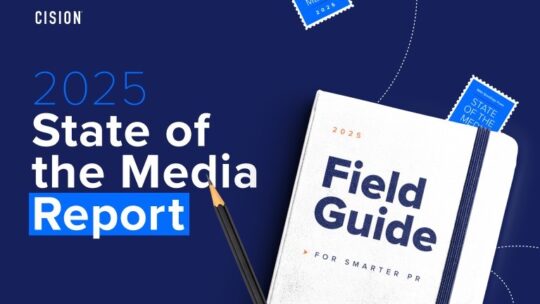
This week's PR Roundup looks at the annual Cision State of the Media Report, what we learned about higher education and crisis at the Meltwater Summit, and new digital data from GIPHY on the papal internet frenzy.
Cision 2025 State of the Media Released
What happened: This week Cision released its 16th annual State of the Media Report which features global media trends across AI, social media, pitching best practices and the evolving role of PR. This year's findings focus on the issues shaping modern journalism—from shifting audience behavior and AI content disruption to the continued demand for relevance, accuracy and real human connection in PR outreach.
Key insights include:
- Relevance: 86% of journalists say they'll immediately reject a pitch that isn't aligned with their beat or audience—underscoring the need for PR teams to do their research.
- Press Releases: 72% of journalists still cite press releases as the most useful resource PR teams can offer. Impact increases when paired with multimedia.
- AI Adoption: Over half of journalists globally now use generative AI tools like ChatGPT, yet 72% worry about factual errors in AI-generated PR content.
- Media Relations: The majority of journalists (85%) say the best way to build a relationship is to introduce yourself via email—even without a story to pitch.
- Social Media: Fragmentation of audiences continues. LinkedIn remains the most-used platform globally, while region-specific platforms like WeChat (China), WhatsApp (EMEA) and Bluesky (North America) show the shifting nature of media engagement.
Communication takeaways: It’s wise for communicators to keep up with current trends in the industry, and particularly about their media counterparts. Paying attention to studies such as this one can provide PR pros with valuable information when reviewing their current media strategies and relationships.
Jim Daxner, Cision’s Chief Product Officer & Head of Strategy, says this year’s report is a powerful reminder that great PR starts with listening.
“Journalists have been candid about what they need—and what they don’t—from communications professionals,” Daxner says. “These insights give PR teams the context to pitch smarter, build stronger relationships and stand out in an increasingly fragmented media landscape. Our report gives [them] the roadmap to be trusted, valuable collaborators.”
The Role of Communications in Higher Ed: Building Trust and Proving Value
What happened: It seems that lately colleges and universities, particularly those with high profile names, are not making the news, but becoming the news. Much of this has to do with the pulling of federal funding by the current administration due to spending cuts and retaliation for sticking with DEI missions and programs.
Some institutions, such as Columbia University, have agreed to the administration’s demands. But others, like Harvard University, have refused government intervention, with its president Alan M. Garber saying that the university “will not surrender its independence or relinquish its constitutional rights.”
So yes, higher education is a very hot topic right now, especially when it comes to crisis communications.
This week the Meltwater Summit hosted a panel featuring senior communications officers from several universities including Howard, Villanova, University of Illinois and The City College of New York, to talk about why strong communications strategy is essential in higher education. The discussion and best practices offered did not disappoint.
Communication takeaways: One of the central themes put forth to proactively prepare for crisis included the breakdown of silos between not only the marketing and communications teams, but also leadership and departments across the campus—something that can also be considered at any corporation or organization.
Dee Dee Mozeleski, Senior Vice President of the Office of Institutional Advancement, Communications and External Relations, City College, said on her first few days in the office she went to each department and asked them what their struggles were. She found answers that were easily solvable by building bridges.
“I asked the fundraisers what their struggles were,” Mozeleski said. “They said we have all these great stories to tell and no one is telling them. I went to the comms team and asked, what are your challenges? They said, ‘There is no good news going on on this campus.’”
Krissy Woods, Director of Public Relations, Villanova University, said all of the comms personnel at the six different colleges that make up Villanova report into central comms, so everyone is speaking the same language.
“If you aren’t interested in building relationships, I don’t know if this [PR] is the right position for you,” Woods said. “This is the greatest joy in my day to day… meeting with faculty and staff… being there, being visible… getting to know people on their turf. When you need someone and don’t know them, it’s tough to bridge those gaps.”
Lydia Sermons, VP and Chief Communications Officer, Howard University, put it simply: establish key relationships in the first days of your position and know who your go-to people are before a crisis.
“The first time you are talking to the chief of police should not be in a crisis,” Sermons said.
Conclave Sparks Internet Frenzy
What happened: As the white smoke wafted from the Sistine Chapel today in Vatican City, the public expressed congratulations to the new Pope, U.S. Cardinal Robert Prevost, who took the name Pope Leo XIV. And maybe it was the movie, “Conclave,” or just genuine human curiosity, but pope fever spread across the internet after Pope Francis was laid to rest following his passing, and the next papal conclave was announced.
GIPHY released new search data from the past six months, showing a definite spike in all things papacy-related in April. According to GIPHY “searches for “conclave” spiked by 219% in April 2025, far surpassing search volumes from October 2024 through March 2025. Over that six-month period—beginning in October 2024, when the film “Conclave” was released, and ending in April 2025—searches for “conclave” rose by 2,672%. Searches for “pope” and “Vatican” also spiked in April, with increases of 281% and 136%, respectively.”
Searches for “white smoke” and “black smoke” also rose significantly according to GIPHY data.
Communication lessons: PRNEWS published a piece on “trend-hopping” this week. One of the public's favorite ways to relate to current events and participate in the cultural zeitgeist is to contribute to the conversation through memes and GIFs. In this case, GIPHY shored up a story and scored a media hit (here), by utilizing “data-driven trendspotting,” as mentioned in the article.
According to GIPHY, utilizing GIFs or memes can help brands to “tap into the zeitgeist” and insert themselves into the conversation (where appropriate.)
“Whether it’s the 2025 papal conclave or March Madness, real-time events and news shape search on GIPHY—driving millions of users to the platform to find the perfect GIF for their chats and memes,” GIPHY states.
Nicole Schuman is Managing Editor at PRNEWS.
